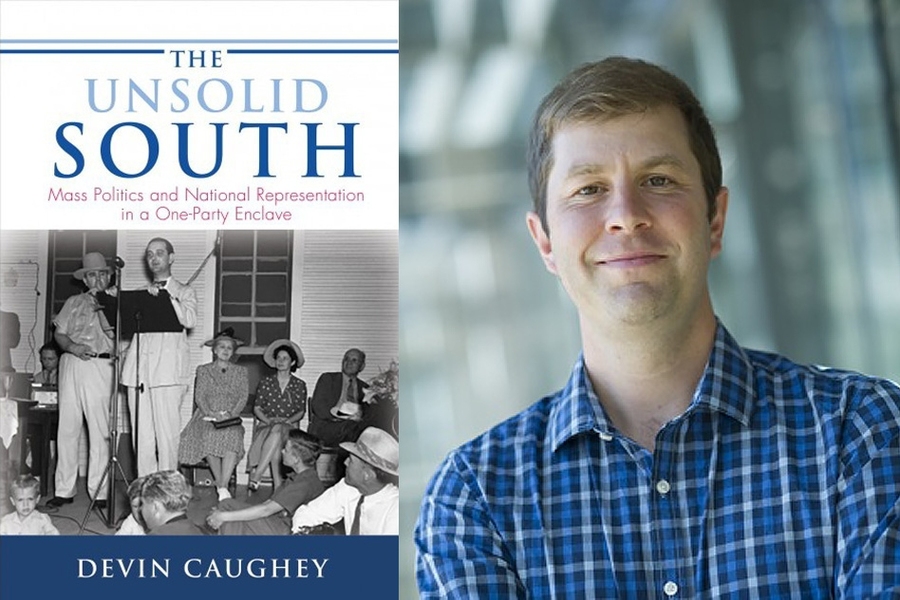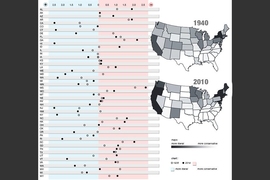In 1938, an ambitious young Texas congressman named Lyndon Johnson voted for a bill called the Fair Labor Standards Act, which established the minimum wage. Most of Johnson’s Democratic Party colleagues joined him.
In 1947, however, Johnson, now a seasoned representative, voted for another bill, the Taft-Hartley Act, which limited the power of labor unions. Passing through a Republican-controlled congress with the help of Southern Democrats, the Taft-Hartley Act helped put the brakes on years of progressive momentum established by the Democratic Party.
“It was an incredibly consequential shift that basically set the limits of the New Deal,” says MIT political scientist Devin Caughey. “It was a critical turning point in American political development.”
It’s fair to say Johnson — later the 36th president of the U.S. — was inconsistent with regard to the interests of labor, as well as his own party. But why? For what reason would a popular Democratic Party politician, in a region controlled by the Democrats, have to zigzag on policy matters? This was the famous “solid South” of the mid-20th century, after all.
To Caughey, there is a clear explanation for why Johnson, and many of his Southern colleagues, reversed course: public pressure. In 1947, Johnson was on the eve of his first U.S. Senate campaign in Texas (which he barely won), and he moved back toward the right politically to help his chances. The strategy seemed necessary because Southern politics had shifted over the previous decade. In the 1930s, the region supported economically progressive legislation, but by the 1940s, much of the South had soured on the New Deal.
“The consequences of this transformation were momentous at the time and continue to reverberate today,” Caughey writes in his new book, “The Unsolid South: Mass Politics and National Representation in a One-Party Enclave,” published this month by Princeton University Press.
As the title suggests, Caughey believes the supposedly “solid South” was not a unitary bloc: Battles within the Democratic Party in the region served as a proxy for for national battles between the two major parties.
“Even though there was no partisan competition in the South, there was intraparty competition,” Caughey says, noting that “once members of Congress were elected, they would divide in ways that aligned either with the Democrats or Republicans nationally.”
But while other interpretations of the Democratic Party in the South at the time depict it as being controlled by elites who ignored the masses, Caughey contends that Southern politicians backed away from their party’s program because voters would not have kept electing them otherwise.
“What really hasn’t been looked at is the connection between mass politics and public opinion, on the one hand, and congressional behavior, on the other,” Caughey says.
Caughey is well-positioned to offer this kind of analysis. Along with his colleague Christopher Warshaw (formerly of MIT, now of George Washington University), and with the aid of student researchers from MIT’s Undergraduate Research Opportunities Program (UROP), Caughey has helped build a massive and unique database of policy decisions and public opinion, spanning the years 1936–2014, which he draws on in his analysis.
Those data have led him to conclude that while one-party domination meant Southern politics were not especially responsive to public opinion at the state level, the two-party competition nationally, between Democrats and Republicans, meant that at the federal level, Southern members of Congress had to heed public opinion. Without doing so, they would lose in Democratic Party primaries to politicians who were more aligned with their constituencies.
“A lot of Democratic Party primary contests in the South were often on the kinds of issues that divided Democrats and Republicans nationally, about the role of government, how high taxes should be, and other classic New Deal issues,” Caughey says.
Of course, as Caughey details in the book, any discussion about public opinion in the South in this era comes with a huge qualification: Segregation prevented almost all African-Americans from voting, so the public opinion that swayed politicians was strictly white public opinion.
“A large chunk of the population was disenfranchised,” Caughey says. “The distinctive regime in the South for most of the first part of the 20th century featured both disenfranchisement and a lack of party competition.”
The issue of racial relations, Caughey notes, also strongly informs the South’s reversal regarding the New Deal. In the 1930s, much of the South supported the New Deal in large part because it brought jobs and infrastructure to what was the country’s most economically lagging region.
White Southerners thus benefitted greatly from the early stages of New Deal legislation. But the emerging, proposed New Deal legislation of the 1940s did not so obviously favor white Southerners specifically. Indeed, an extension of economically progressive legislation may well have dealt a major setback to segregation.
“Part of it was the growing fear that the New Deal state posed a potential and maybe actual threat to Jim Crow in the South,” Caughey says. “So racial fears came to the fore.”
At the same time, Southerners were already more resistant to unions than people in other regions; the extent to which the New Deal might help organized labor also fed Southern antipathy toward economically liberal politicians. As Caughey notes in the book, by 1944, 81 percent of white Southerners stated they would oppose a candidate supported by the Congress of Industrial Organizations (CIO), as opposed to 61 percent in the rest of the country.
Scholars say Caughey’s book is a valuable addition to the field. David Mayhew, a professor of political science at Yale University, has called it “fresh, convincing, and written with the utmost skill, intelligence, and knowledge of the historical territory.”
As Caughey discusses in the book, the South’s turn against the New Deal is just one of two major reversals the region witnessed in the 20th century. The other was its even more famous flip away from the Democrats after the Civil Rights Act of 1964 — signed by, yes, President Lyndon Johnson — to the point where the region is now heavily controlled by the Republican Party.
The current dynamics, Caughey writes, still “exhibit an extraordinary degree of ideological and partisan polarization by race.” For his part, Caughey adds, he would like the book to open up avenues for further research about conditions of one-party domination in politics, something he affirms in the book’s conclusion: “My hope is the questions raised in this book will spur other scholars to pursue a broader research agenda on representation and democracy in one-party settings around the world.”









